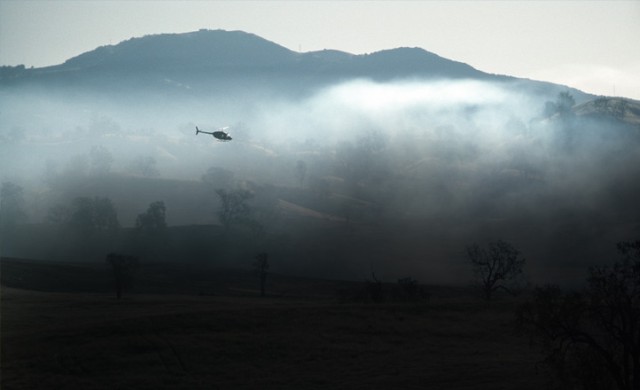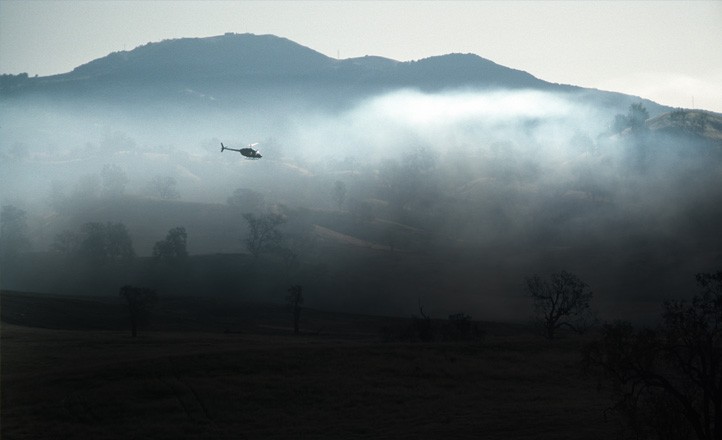
GYPSUM, Colo. -- Mid-October in the Rockies is no place to be on an outing by yourself, especially if you're unprepared. During this time, the pilots at the High-Altitude Army Aviation Training Site (HAATS) typically spend their search and rescue time looking for lost hunters, but not so on this day.
Two out-of-state hikers decided to climb Holy Cross Mountain, which is close to Leadville, Colo. Armed with only tennis shoes and a pack of cigarettes, the hikers climbed to the summit. On the way down, one of the hikers picked up the pace back to camp only to stop at a second trailhead to wait for his friend, who never arrived. Ground teams began searching the following day as 18 inches of snow fell in the high country. The next day, HAATS dispatched an OH-58A to aid in the search.
The aircrew's first mission was to insert six individuals and a search dog to a location where searchers believed the lost hiker had built a fire the previous day. The landing zone (LZ) was about 12,500 feet mean sea level (MSL) in fresh powder and swirling winds. With the lost hiker expected to have hypothermia at this point, there wasn't a whole lot of time to debate whether the aircraft could make it. There was no time for guessing.
Two passengers and a search dog were loaded onto the aircraft and inserted into the LZ, followed by a second lift of two passengers until all were in place. Shortly after arriving, they found the lost hiker close to one of the ground crews and took him to safety. Although suffering from hypothermia and frostbite to his ankles, this man lived to tell his tale. Others have not been as lucky.
So how did these pilots land a fully loaded OH-58A at 12,500 feet in swirling wind and whiteout conditions' The answer is they didn't "think" they could make it; they knew they could! They were able to place ground teams in a position to rescue the hiker and save his life, instead of becoming victims themselves. It was neither magic nor recklessness on the pilots' part. They clearly understood three principal points of power management: understanding the environment, their aircraft and themselves.
Understanding The Environment
First, the pilots understood their environment, not simply because Holy Cross Mountain is in their backyard, but because the pilots understood winds and density altitude. Winds move over and around obstacles in a consistent and, therefore, predictable manner. Understanding the mechanical turbulence created by these winds allows a pilot to avoid "bad air" - the downdraft/turbulent areas that require extra power to overcome - that could result in loss of aircraft control. The pilot understood that staying in "good air," or the updraft sides of canyons and valleys, would increase his lift, effectively improving his margin of safety. This provided useable power that wouldn't normally be present on a calm day at the same density altitude. Winds also played a part in mitigating whiteout on short final to the LZ by keeping the snow cloud generated by the rotor wash behind the pilot's field of view. This allowed the pilots to attempt the landing with less than out-of-ground effect (OGE) power available because they could use the ground effect safely.
Density altitude is another critical environmental factor. The aircraft has only so much power, and increasing both the pressure altitude and temperature reduces that. However, in this case, there was an increase in the pressure altitude by being at 12,500 feet MSL. The temperatures in October, especially after a cooling snowstorm, did not increase the density altitude to the point where a safe landing could be accomplished with the given loads. Aviators correct for density altitude in their performance planning, whether they realize it or not, any time they use temperature and pressure altitude to determine a power number. This is also true in the tabular data used to determine the power numbers for this mission.
Understanding The Aircraft
The second principal is they understood the aircraft. The single-engine OH-58A is capable of some amazing feats if you understand what it takes to fly it. The pilots understood there would be no OGE power available to get into the LZ. This might have been a limiting factor were the winds lighter (due to whiteout) or the LZ was a small, confined area (possibly requiring OGE power to depart). Neither was the case, so the pilots were able to make a controlled approach and use in-ground-effect power to set the aircraft down gently.
The OH-58 also has a caution located in the performance planning section of the operator's manual that pilots often see, but seldom remember. The caution states that low-altitude maneuvering flights at airspeeds below 35 knots are not recommended under conditions where power required to hover OGE exceeds maximum continuous power (available). Pilots don't often encounter this flight condition, so they typically forget this caution unless it's applied during search-and-rescue operations in the high country. This caution, coupled with the knowledge of how to avoid loss of tail rotor effectiveness, was in the back of the pilots' minds as they maneuvered in the search area. They mitigated this problem by avoiding downdraft and tailwind conditions and maintaining airspeed, especially while turning in the canyons and valleys.
Understanding Themselves
Third, the pilots understood themselves. While most of us aviators don't like to admit it, we all have personal limits. It's a matter of understanding the limits of your personal abilities. Knowing your personal limitations will help you make smarter and safer decisions. This is extremely important with single-pilot aircraft. There is nothing wrong with admitting you have never done a particular kind of mission or task before, or that it is outside your comfort level.
To expand your envelope of abilities, you must train with a seasoned professional on the tasks you have never done before. Someone wanting to learn how to fly in mountainous terrain or overwater operations would not go out with a flight instructor who had never done these tasks. With a flight crew of more than one person, knowing your personal limitations will allow you to draw upon the experience level of the entire crew. The goal of pilots "understanding themselves" is not to be the limiting factor in success or failure. If your performance planning says the aircraft can do the task required, the pilot, as a professional aviator, should not be the limiting factor.
Summary
You can't really sum up power management and its tactics, techniques and procedures in this one article. Each aircraft and condition provides its own challenges. The three points that are fundamental to understanding power management apply to all aircraft and pilots. Understanding and applying knowledge of the environment, the aircraft and yourself may mean the difference between making a successful rescue or becoming a victim.

Social Sharing